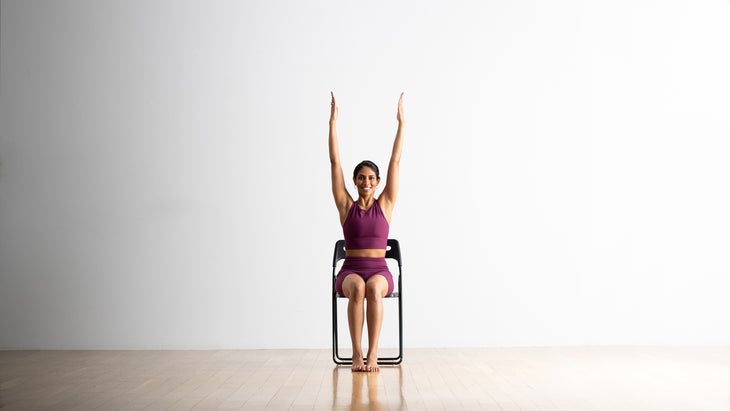Heading out the door? Read this article on the new Outside+ app available now on iOS devices for members! Download the app.
Urdhva Hastasana (Upward Salute) might seem like one of easiest poses in yoga at first glance, but it requires attention and focus. Along with Tadasana (Mountain Pose), it is a foundation pose for all standing poses including Vrksasana (Tree Pose), Utkatasana (Chair Pose), and flows like Surya Namaskar (Sun Salutation).
Upward Salute teaches extension from the ground up: Lengthen from your side waist while strengthening your arms and shoulders. Mindfully explore the opposing forces at play as you ground down through your feet and lift your arms above your head. Close your eyes and feel the strength of your body, knowing you are fully supported by the ground. Feel the energy move up and down your spine with each breath as you stand tall and reach for the sky. Focusing your attention to your breath can ease anxiety and stress, preparing you for your day or the rest of your asana practice.
Upward Salute Basics
Sanskrit: Urdhva Hastasana (OORD-vah hahs-TAHS-ah-nah)
Pose type: Standing posture
Targets: Full body
Why we love it: “This pose really stretches my shoulders—and opens my chest,” says Ellen O’Brien, Yoga Journal staff writer. “I love doing this as a counter pose after a long hold in Garudasana (Eagle Pose). After having my shoulders wrapped up and activated for an extended period of time, Upward Salute gives them some much-needed relief.”
Pose benefits
As a belly-stretching pose, Upward Salute can help improve your digestion. It is also a great pose for stretching the shoulders and arms.
Upward Salute: Step-by-step instructions
-
- Stand with your big toes touching and a small amount of space between your heels. Root down with your big toe mounds, your heels and the outside edges of your feet. Pull up with your inner arches.
- Rotate your inner thighs back and gently release your tailbone toward your heels.
- Draw your shoulders back, soften your front ribs, and stack the crown of your head above your pelvis, lifting your chin parallel to the floor.
- Raise your arms overhead with your hands shoulder distance apart and palms facing each other.
- Draw your arms in line with your ears. Rotate your biceps back and allow your shoulder blades to move up and out away from your spine.
- If you’re able to keep your arms straight, reach up and touch your palms, bringing your gaze to your thumbs.
- Take several breaths, then release your arms.
Teaching Upward Salute
These cues will help protect your students from injury and help them have the best experience of the pose:
- If straightening your raised arms is a challenge, practice with a shoulder-width loop around your upper arms, secured just above the elbows.
- Practice keeping your front ribs from lifting. Keep a softness in your ribs and lower them toward your front hip bones.
Variation: Stable Upward Salute

(Photo: Andrew Clark)
For a more stable base, practice with your feet hip-distance apart. Bring your arms more to a V shape at whatever width and height is comfortable for you. They may be more forward if you have shoulder limitations.
Variation: Upward Salute on a chair

Sit on a chair with your feet flat on the floor and your big toes touching. Root down through your sit bones and reach the crown of your head toward the ceiling, lengthening your spine. Raise your arms straight up overhead with your palms facing each other.
Variation: Supine Upward Salute

Lie down on your mat with your legs extended and your feet flexed. Reach your arms up overhead and allow them to extend along the floor, palms facing each other. Maintain the natural curves of your spine; there will be space between the floor and your neck and lower back.
Preparatory poses
Tadasana (Mountain Pose)
Counter poses
Tadasana (Mountain Pose)
Uttanasana (Standing Forward Bend)